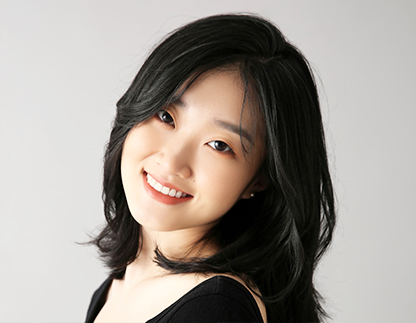I found that as I am working in an interdisciplinary field, it is very helpful to talk to people in different areas. They can always give me ideas I would never think of myself!”
Ouxun Jiang (she/her)
PhD Student in the Department of Psychology

Ouxun is a PhD student in the Department of Psychology in the Weinberg College of Arts and Sciences. She works in the Visual Thinking Lab, where she studies animated data visualizations in conjunction with people's visual processing capabilities. Ouxun was awarded the Northwestern Design Cluster Fellowship and recently received the Northwestern Cognitive Science Advanced Fellowship.
How would you describe your research and/or work to a non-academic audience?
Imagine a dot plot showing the populations of 50 countries, animated to show how those values change over time. The display is engaging, but the amount of motion and change is also overwhelming. I study animated data visualization and, more specifically, how to make them clearer for people to read and understand. Animated visualizations effectively show changes and are engaging to watch, but they also easily confuse people with their complexity. Trying to track the changes in an animated data visualization feels like a magic trick in which the magician hides a ball under one of several cups, shuffles them around quickly, and then asks you under which cup is the ball. It would be very difficult if there were too many cups or if the shuffling was too quick. The goal of my research project is to categorize tasks used when viewing animated visualizations, evaluate people’s processing capacity for each, and summarize techniques that designers can use to make these tasks easier.
What have been some of the most memorable twists and turns of your career?
My initial interest was in clinical psychology. When I was an undergraduate volunteering at a lab that studies depression and anxiety, I helped run behavioral assessments with participants and found that they had very different reactions and strategies when completing the memory tasks. Inspired by this, I decided to switch to cognitive psychology and became a research assistant in a memory and aging lab. I worked with my graduate mentor on projects about graphical memory across the lifespan, which piqued my interest in studying data visualization.
What is the biggest potential impact or implication of your work?
I aim to develop a guidebook for designers to create animated data visualizations that respect viewers’ processing limits. This guidebook would include some common design intentions, visual tasks, and techniques to overcome the processing limits. Along with the guidebook, we also expect to create videos that summarize sections of the guidebook to show animation demonstrations and to increase engagement for both professionals and general audiences. Hopefully, this will improve the overall quality of data visualizations across various fields, including business, journalism, and science communication.
How do you unwind after a long day?
A nap and some good food are always the best! I sometimes also dance to make myself relaxed.
What did you originally want to be when you grew up?
I wanted to become a dancer of Chinese dance or ballet, so I am switching from visual arts to visual science!
What advice would you give your younger self or someone considering a similar path?
I found that as I am working in an interdisciplinary field, it is very helpful to talk to people in different areas. They can always give me ideas I would never think of myself!
Published: February 21, 2023
If you know a graduate student, postdoctoral trainee, graduate faculty member, staff member, or a member of our TGS alumni population who would make a great candidate for our TGS Spotlight Series, please complete this brief TGS Spotlight Series Nomination Form.